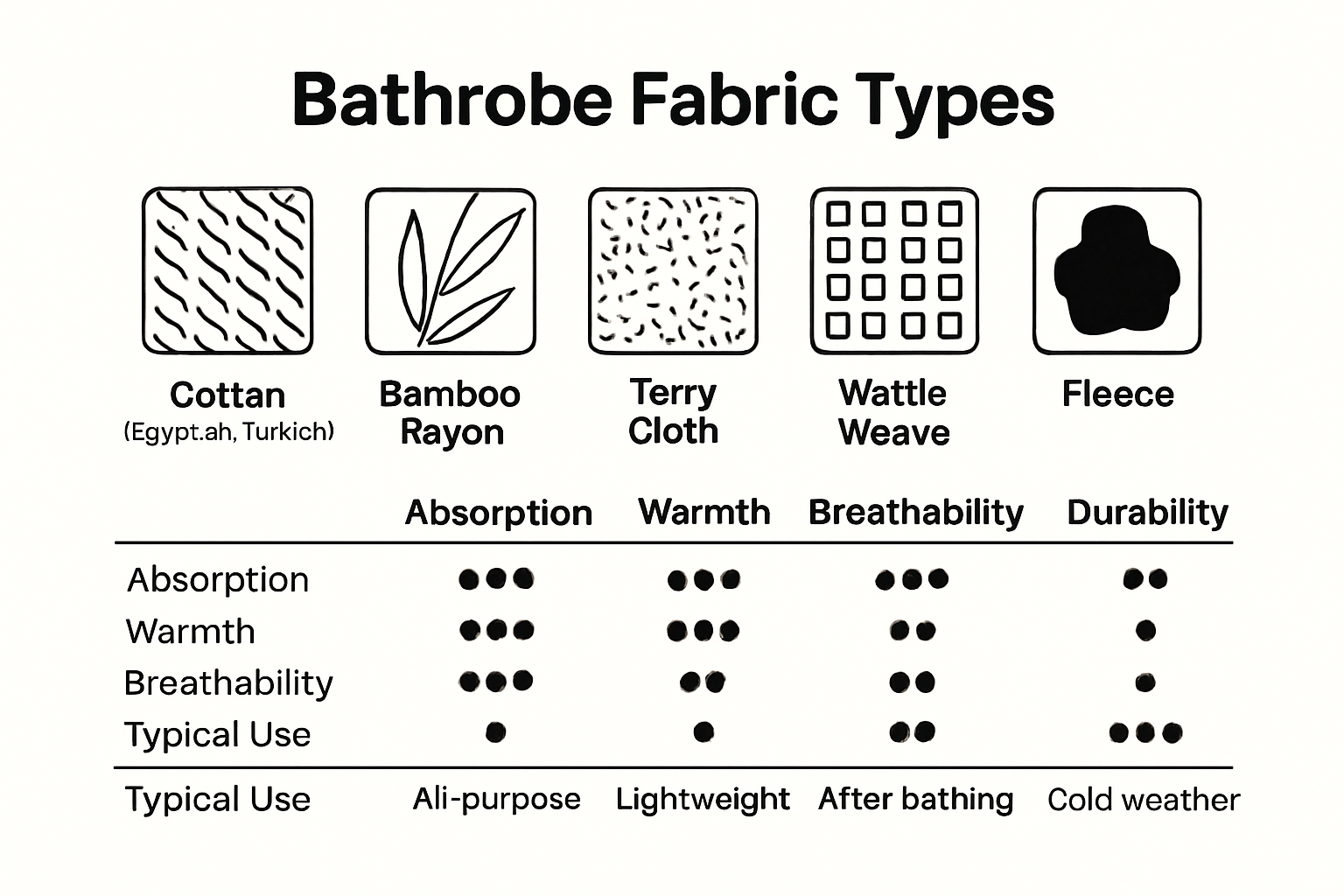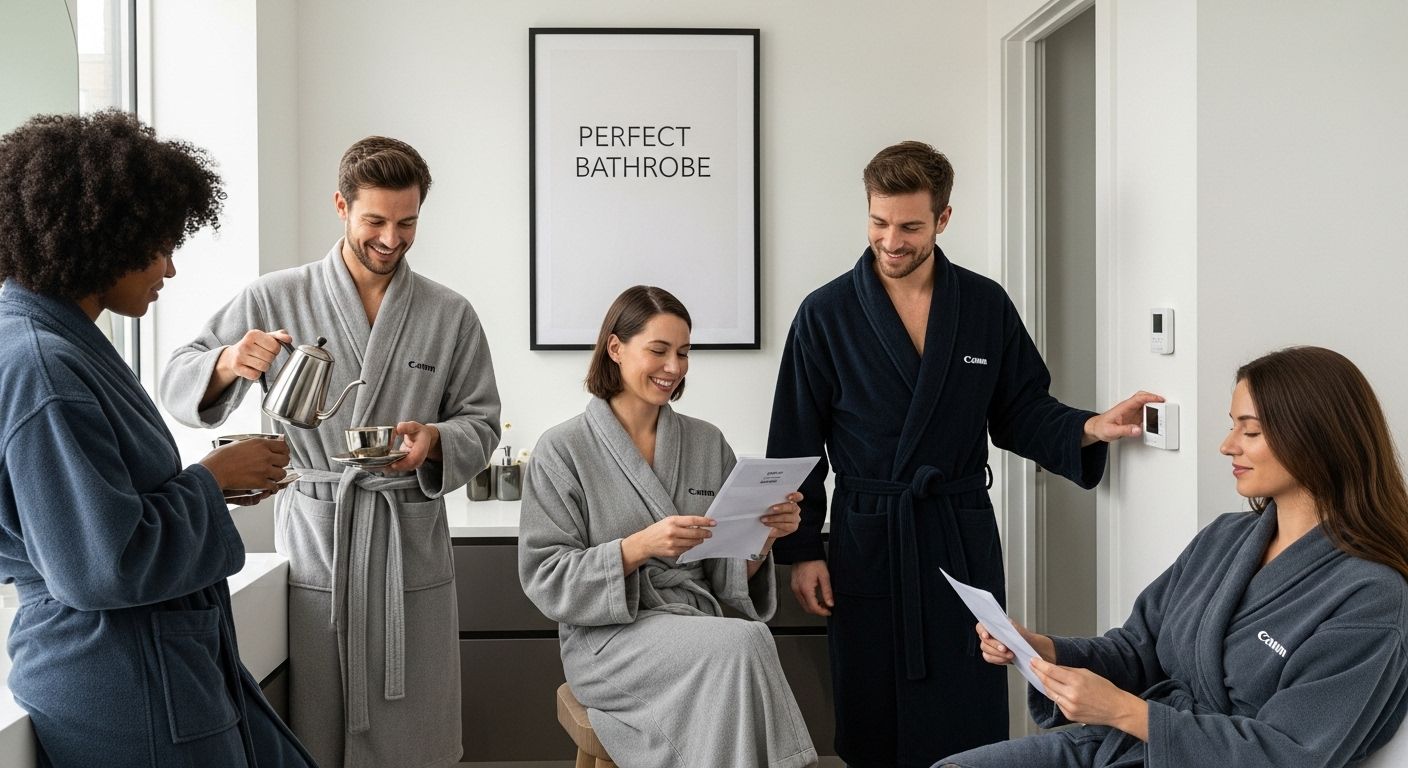
Slip into a bathrobe and you are joining a tradition that stretches back centuries. Most people imagine bathrobes as simple comfort wear after a shower or lazy weekend mornings. But the real story is much bigger. These cozy garments were once exclusive status symbols for European aristocrats in the 1600s and even influenced by the intellectual elite of the age. Today, with innovations like temperature-regulating textiles and customizable fits, the bathrobe is making a comeback—not as outdated loungewear, but as a personal wellness essential that connects fashion, history, and self-care in surprising ways.
Table of Contents
- Origins And Evolution Of Bathrobes
- Bathrobes In Culture And Daily Life
- Modern Bathrobe Trends And Innovations
- How To Choose The Perfect Bathrobe Today
Quick Summary
| Takeaway | Explanation |
|---|---|
| Bathrobes originated from aristocratic loungewear. | Bathrobes evolved from luxury garments among European elites, symbolizing social status and leisure since the 17th century. |
| Terry cloth revolutionized bathrobe comfort. | The introduction of terry cloth in the early 20th century made bathrobes more accessible, shifting their status from luxury to everyday comfort. |
| Modern bathrobes focus on smart technology. | Innovations in textile design, such as temperature-regulating materials, enhance comfort and personalize the wearing experience. |
| Choosing a bathrobe involves understanding materials. | Fabric selection is essential; options like cotton and fleece offer varying benefits for softness, absorbency, and warmth. |
| Fit and functionality are key for comfort. | The ideal bathrobe should fit well and serve your specific needs, ensuring ease of movement and practicality. |
Origins and Evolution of Bathrobes
The history of bathrobes is a fascinating journey through comfort, culture, and personal expression. Far from being a modern invention, bathrobes have a rich historical tapestry that spans centuries, transforming from elaborate luxury garments to the cozy, practical items we know today.
The Aristocratic Roots of Loungewear
In the 17th century, the concept of a personal, comfortable indoor garment emerged among European aristocracy. Historical fashion research reveals that fashionable gentlemen began wearing full-length morning gowns that were far more than simple clothing. These elaborate robes, often crafted from expensive silk brocade, damask, velvet, and chintz, represented a symbol of social status and refined leisure.
The banyan, an 18th-century loose-fitting garment, became a particularly significant predecessor to modern bathrobes. Textile historians note that intellectuals and philosophers frequently wore these garments, creating an association between the robe and scholarly sophistication. Made from luxurious linens and silks, banyans were not just clothing but statements of intellectual and social standing.
Technological Innovation and Comfort
The early 20th century marked a revolutionary transformation in bathrobe design. The introduction of terry cloth fundamentally changed how people experienced personal comfort. Textile innovation research indicates that this absorbent fabric made bathrobes more practical and accessible to a broader population.
Terry cloth’s unique properties allowed bathrobes to transition from exclusive aristocratic wear to a mainstream comfort item. Suddenly, the luxurious feeling of a soft, enveloping garment was no longer limited to the wealthy. Families, hotels, and individuals could now enjoy the comfort that was once reserved for the elite.
This technological advancement democratized the bathrobe, transforming it from a status symbol to a universal item of personal comfort. The evolution reflected broader societal changes—a move towards valuing personal relaxation, hygiene, and individual well-being.
Today’s bathrobes continue this legacy of comfort and personal expression. From plush hotel robes to personalized spa accessories, they remain a testament to humanity’s enduring desire for comfort and self-care. The journey of the bathrobe mirrors our own: always evolving, always seeking greater comfort and personal connection.
Whether you’re wrapping yourself in a soft terry cloth robe after a shower or lounging in a luxurious silk garment, you’re participating in a centuries-old tradition of comfort and personal indulgence.
Bathrobes in Culture and Daily Life
Bathrobes have transcended their original purpose, becoming more than just a garment. They represent comfort, personal expression, and cultural significance that extends far beyond simple clothing.
A Symbol of Domestic Sophistication
Historical fashion research reveals that bathrobes initially emerged as a statement of social refinement. In the 17th and 18th centuries, these garments were not merely clothing but a complex cultural artifact. Wealthy men would wear elaborate robes adorned with exotic fabrics imported from Japan and India, signaling their worldliness and intellectual status.
For women of the mid-1800s, textile historians note that dressing gowns provided a rare moment of personal comfort. Confined by tight corsets and multiple petticoats, these robes offered a welcome respite. They were crafted from exclusive fabrics, allowing women to maintain a sense of decency and elegance even in private spaces.
Personal Sanctuary and Self-Care
Today, bathrobes have evolved into a powerful symbol of personal wellness and self-care. They represent a transition space between public and private life, a moment of pause and relaxation. Whether after a shower, during a lazy weekend morning, or following an intense workout, bathrobes create a personal sanctuary of comfort.
In modern culture, bathrobes have become ubiquitous in various settings. Luxury hotels provide plush robes as a marker of hospitality. Spas offer them as part of a complete relaxation experience. Home bathrooms have transformed from purely functional spaces to personal retreats, with the bathrobe playing a central role in this transformation.
Cultural Expressions and Personal Identity
Bathrobes now serve as a canvas for personal expression. From vibrant colors to unique patterns, they reflect individual style and personality. Some people collect bathrobes from different destinations, turning them into travel mementos. Others choose robes that match their home decor or personal aesthetic.
In many cultures, bathrobes have taken on additional meanings. In Japan, the traditional yukata represents a form of casual robe with deep cultural significance. In Turkish hammams, special bathrobes are part of a centuries-old bathing ritual. These cultural variations demonstrate how a seemingly simple garment can carry profound cultural and personal meanings.
Whether you see a bathrobe as a practical item, a luxury accessory, or a personal statement, its role in our daily lives is undeniable. It is a garment that bridges comfort, culture, and personal identity—a true testament to human creativity and the universal desire for personal well-being.
Modern Bathrobe Trends and Innovations
The world of bathrobes is experiencing a remarkable transformation, driven by technological advancements, sustainability concerns, and evolving consumer preferences. Modern innovations are reimagining this classic garment, turning it from a simple piece of clothing into a sophisticated, functional experience.
Smart Textile Technologies
Cutting-edge research in textile engineering is revolutionizing bathrobe design. Scientists have developed integrated cooling textiles that manage perspiration and body temperature with unprecedented precision. These innovative fabrics go beyond traditional moisture-wicking capabilities, creating bathrobes that actively respond to the wearer’s physiological needs.
Advanced textile research has introduced graphene-enabled adaptive materials that can dynamically adjust their thermal properties. Imagine a bathrobe that automatically regulates its temperature, keeping you cool when you’re warm and providing warmth when you’re chilly. This isn’t science fiction—it’s the emerging reality of smart textile technologies.
Sustainability and Customization
Environmental consciousness is driving significant changes in bathrobe manufacturing. Innovative textile systems now allow for re-moldable fabrics that can adapt to changing body shapes and preferences. This approach reduces waste by creating garments that evolve with the user, challenging the traditional disposable fashion model.
Customization has become a key trend. Consumers now expect bathrobes that reflect their personal style, body type, and specific comfort needs. Manufacturers are responding with made-to-measure options, advanced sizing technologies, and personalization features that transform bathrobes from generic items to individual statements.
Wellness and Performance Design
Modern bathrobes are no longer just about post-bath comfort. They’re becoming integral to personal wellness routines. Performance fabrics with antimicrobial properties, enhanced moisture management, and therapeutic textures are turning bathrobes into wellness tools.
Some cutting-edge designs incorporate elements from athletic wear and spa technology. Bathrobes now feature compression zones, targeted support areas, and materials that promote relaxation and recovery. They’re being designed not just as clothing, but as holistic wellness experiences that support physical and mental well-being.
The future of bathrobes is about more than fabric and design—it’s about creating personalized, adaptive garments that respond to individual needs. From temperature-regulating materials to customizable fits, these innovations represent a profound shift in how we think about comfort and personal care.
As technology continues to advance, bathrobes will likely become even more sophisticated. They’ll be smart, responsive, sustainable, and deeply personalized—a far cry from the simple garments of previous generations. The bathrobe is no longer just something you wear; it’s becoming an experience tailored specifically to you.
How to Choose the Perfect Bathrobe Today
Selecting the perfect bathrobe is more than a simple shopping decision—it’s about finding a personal comfort companion that meets your unique needs and preferences. With countless options available, understanding key selection criteria can transform your bathrobe from a mere garment to a daily luxury experience.
Understanding Fabric and Material Essentials
Textile research reveals that bathrobe materials dramatically impact comfort and functionality. Different fabrics offer unique advantages, making material selection crucial. Cotton remains a classic choice, prized for its natural absorbency and breathability. Fabric experts recommend exploring variations like Egyptian cotton for superior softness, Turkish cotton for enhanced durability, and bamboo-derived rayon for exceptional moisture-wicking properties.
Each fabric type presents distinct characteristics. Terry cloth provides maximum absorption, making it ideal for post-shower use. Waffle weave offers lightweight breathability, perfect for warmer climates. Fleece delivers warmth and softness, excellent for cooler environments. Understanding these nuanced differences helps you select a bathrobe that genuinely complements your lifestyle and personal comfort preferences.
To help you compare bathrobe materials and choose what best suits your needs, here’s a summary of the main fabrics discussed and their distinctive qualities:
| Fabric Type | Key Qualities | Best For |
|---|---|---|
| Cotton | Absorbent, breathable | General use, all-around comfort |
| Egyptian Cotton | Ultra-soft, high absorbency | Luxury feel, spa-like comfort |
| Turkish Cotton | Durable, good absorbency | Long-lasting, frequent use |
| Bamboo-derived Rayon | Moisture-wicking, soft, eco-friendly | Humid climates, sensitive skin |
| Terry Cloth | Maximum absorption, plush texture | Post-shower, hotel use |
| Waffle Weave | Lightweight, breathable | Warm climates, travel |
| Fleece | Warm, extremely soft | Cold environments, lounging |

Fit, Comfort, and Functionality
Comfort specialists emphasize that the perfect bathrobe transcends material—it’s about finding the right fit and functionality. Consider your primary use: Are you seeking a post-shower wrap, a loungewear piece, or a versatile garment for multiple purposes?
Size and cut are critical considerations. A well-fitted bathrobe should allow comfortable movement without feeling restrictive. Pay attention to sleeve length, overall length, and shoulder width. Some individuals prefer a relaxed, oversized fit for maximum comfort, while others opt for a more tailored silhouette.
Personal Style and Maintenance
Beyond technical specifications, your bathrobe is a personal expression of style and self-care. Consider color, pattern, and design that resonate with your aesthetic. Some prefer classic, neutral tones that blend seamlessly with home decor, while others embrace bold, vibrant designs that make a statement.
Maintenance is another crucial factor. Examine care instructions carefully. Some high-end materials require specialized cleaning, while others offer easy, machine-washable convenience. Consider your lifestyle and willingness to provide specialized care when making your selection.
Here’s a quick guide to key considerations when selecting your perfect bathrobe, breaking down the main decision points and what to look for:
| Selection Factor | What to Consider |
|---|---|
| Primary Purpose | Post-shower, lounging, or versatile use |
| Fit & Cut | Comfortable movement, not restrictive |
| Sleeve & Robe Length | Desired coverage and ease of movement |
| Personal Style | Color, pattern, and design preferences |
| Care & Maintenance | Machine-washable or special cleaning required |
| Material Choice | Softness, absorbency, breathability, warmth |
Choosing the perfect bathrobe is a personal journey. It’s about understanding your comfort needs, aesthetic preferences, and practical requirements. Whether you prioritize luxurious softness, exceptional absorbency, or versatile design, the right bathrobe can elevate your daily routine from mundane to magnificent.
Remember, a great bathrobe is more than fabric—it’s a daily invitation to comfort, relaxation, and personal indulgence. Take time to explore, try different options, and find the bathrobe that feels like it was crafted specifically for you.

Frequently Asked Questions
What is the origin of bathrobes?
Bathrobes originated from aristocratic loungewear in the 17th century, initially worn by European elites as a symbol of social status and refined leisure.
How have bathrobes evolved over time?
Bathrobes have transitioned from luxury garments made of expensive fabrics to everyday comfort items made from absorbent materials like terry cloth, making them accessible to a wider audience.
What materials are best for bathrobes?
The best materials for bathrobes include cotton for absorbency, bamboo-derived rayon for moisture-wicking, terry cloth for maximum absorption, and fleece for warmth, depending on your personal comfort needs.
How do I choose the right bathrobe for my needs?
Choosing the right bathrobe involves considering factors like primary usage (post-shower or lounging), fit and cut (tailored or oversized), and personal style (color and pattern preferences) to ensure it meets your comfort requirements.
Step Into the Legacy of Comfort – Redefine Your Bathrobe Experience
Throughout history, bathrobes have shifted from exclusive luxury to a symbol of personal comfort and well-being. If you have ever struggled to find a robe that truly feels indulgent, fits your lifestyle, and matches your sense of style, you are not alone. The article explores frustrations such as choosing the right fabric, balancing practicality with elegance, and discovering a robe that is more than just after-shower wear. Now you can bridge centuries of tradition with modern design, creating your own daily sanctuary with help from Lotus Linen.

Embrace a new era of self-care and elevate your comfort routine. Browse our collection of plush robes, customizable options, and spa-quality loungewear designed to meet every need. Make your bathrobe a true reflection of personal history and comfort. Visit https://shoplotuslinen.com now and discover the robe you have always deserved.
